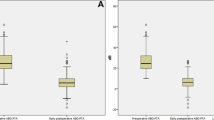Abstract
Patients with elevated bone conduction (BC) thresholds are not considered a good candidate for otosclerosis surgery. Sometimes, it might be difficult to decide to operate these patients considering relatively poor cochlear function. However, viewpoints may vary among otologists. This study was undertaken to compare hearing outcome following otosclerosis surgery in patients who had bone conduction (BC) thresholds ≥ 30 dB, and to investigate whether BC thresholds >30 dB has a negative impact on hearing outcome. Medical records of 111 patients who had undergone otosclerosis surgery were reviewed. Of 111 patients, 83 had undergone stapedotomy, and 28 stapedectomy. The patients were grouped based on preoperative four-tone BC threshold. Eighty-seven patients had average BC threshold ≤ 30 dB, and were assigned to good-cochlear reserve group. The remaining 24 patients had average BC > 30 dB, and constituted poor-cochlear reserve group. Pre- and postoperative air conduction (AC) and BC thresholds, air-bone (AB) gap, vocal audiometry results and amount of deterioration in BC were determined. Mean postoperative AB gap was almost the same in both groups (14 and 15 dB) (P > 0.05). Percentage of AB gap = 10 dB favored good-cochlear reserve group (41 vs 29%)(P > 0.05). Analysis of mean hearing gain was slightly in favor of good-cochlear reserve group (19 vs 15 dB) (P > 0.05). Better BC thresholds were obtained postoperatively in good-cochlear reserve group (P < 0.001). Deterioration > 10 dB in BC was observed in 5.7 and 12.5% of the patients with good- and poor-cochlear reserve, respectively (P > 0.05). Based on the results of this small sample-size study, even though BC threshold of 30 dB was not considered a negative factor for hearing gain, otosclerosis surgery might have detrimental effects on postoperative BC thresholds in patients who had BC thresholds >30 dB.
Similar content being viewed by others
References
Awengen DF (1993) Change of bone conduction thresholds by total footplate stapedectomy in relation to age. Am J Otolaryngol 14:105–110
Balle V, Linthicum Jr FH (1984) Histologically proven cochlear otosclerosis with pure sensorineural hearing loss. Ann Otol Rhinol Laryngol 93:105–111
Committee on hearing and equilibrium (1995) Committee on Hearing and Equilibrium guidelines for the evaluation of results of treatment of conductive hearing loss. Otolaryngol Head Neck Surg 113:186–187
Ramsay HAW, Linthicum Jr FH (1994) Mixed hearing loss in otosclerosis:indication for long-term follow-up. Am J Otol 15:536–539
Rüedi L (1969) Otosclerotic lesion and cochlear degeneration. Arch Otolaryngol 89:364–371
Schucnecht HF, Kirchner JC (1974) Cochlear otosclerosis: fact of fantasy. Laryngoscope 84:766–782
Schucnecht HF, Barber W (1985) Histologic variants in otosclerosis. Laryngoscope 95:1307–1317
Sheehy JL (1978) Surgical correction for far-advanced otosclerosis. Otolaryngol Clin North Am 11:121–123
Vartiainen E, Karjalainen S (1992) Bone conduction thresholds in patients with otosclerosis. Am J Otolaryngol 13:234–236
Vartiainen E, Vartiainen J (1995) The effect of preoperative bone conduction audiometry. Eur Arch Otorhinolaryngol 252:459–461
Author information
Authors and Affiliations
Corresponding author
Rights and permissions
About this article
Cite this article
Satar, B., Şen, D., Karahatay, S. et al. Effect of cochlear reserve on postoperative outcome in otosclerosis. Eur Arch Otorhinolaryngol 264, 489–493 (2007). https://doi.org/10.1007/s00405-006-0205-9
Received:
Accepted:
Published:
Issue Date:
DOI: https://doi.org/10.1007/s00405-006-0205-9




